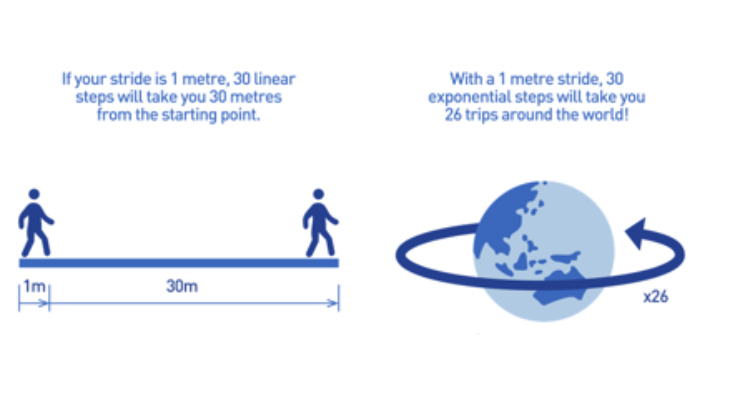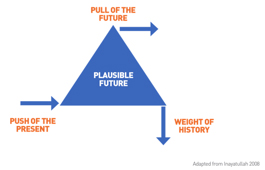Leading in a world of exponential technologies

As humans we are designed to think in linear terms. This produces a paradox for educational leaders. It is very hard for us to see what is about to happen as all we can draw on is what has happened which has largely been linear.
“[T]he future will be far more surprising than most people realize, because few observers have truly internalized the implications of the fact that the rate of change itself is accelerating.” Ray Kurzweil, The Singularity Is Near (2005)
The point is we often miss exponential trends in their early stages because the initial pace of exponential change is deceptive. It begins slow and steady and is hard to differentiate from linear change.
Exponential Change is deceptive, then explosive
The phrase ‘Exponential Change’ is increasingly being used and heard in a wide range of contexts but what does it actually mean? Unlike linear change, which results from repeatedly adding a constant, exponential change is the repeated multiplication of a constant. If you were graphing linear change it would produces a stable straight line over time. Exponential change produces a line that skyrockets.
An insightful way of explaining exponential change is seen in Figure 1. It compares the distance travelled by taking 30 one metre steps to that of the distance travelled by 30 exponential steps. Thirty linear steps of one metre will take you 30 metres, but if you double your stride each step, you progress the same distance with each step as all the previous steps combined. Before you hit a billion miles at step 30, you’re at 500 million miles at step 29. That means that any of your previous steps look minuscule compared with the last few steps of explosive growth, and most of the growth happens over a relatively short period of time.
As David B Petersen, Director at the Center of Expertise, Leadership Development & Executive Coaching at Google, said recently: “Things are changing faster. We need to learn faster and better. We need to help leaders learn and adopt faster. Different kinds of things are changing in different ways. We need to learn different kinds of things faster, in different ways. We need to help leaders adapt and innovate in new ways, faster”
Leading into the Futures – Shock and AWE
Given the challenges identified above how do leaders successfully lead?
Unfortunately, there is no single right answer but there are some clues from the field of Futures or Foresight Thinking to help leaders navigate the emerging future.
The first aspect is around SHOCK there is a fine line between shocking people enough to push them towards action and shocking them too much that they experience what Alvin Toffler might call Future Shock, which can lead to either putting their heads in the sand and hoping it goes away or dismissing it based on the linear thinking that we are pre-dispositioned to do.
So, I like to use the phrase ‘positively disrupt’ which hopefully gets the balance right, alongside the importance of wanting people to take action – AWE. This is deliberately in capital letters as it stands for And Where Emerges. Taking people from an uncomfortable state of shock into what action they can take to bring about a preferred future.
Tools and Frameworks
The use of tools and frameworks is also a helpful way to enable leaders make sense and think about the future with their staff. Two such tools and frameworks are The Futures Triangle and The User’s Guide to the Future.
 The Futures Triangle: Professor Sohail Inyatullah developed The Futures Triangle, shown in diagram 2, is a useful tool to start the thinking process as it helps us to map our current views of the future through 3 dimensions:
The Futures Triangle: Professor Sohail Inyatullah developed The Futures Triangle, shown in diagram 2, is a useful tool to start the thinking process as it helps us to map our current views of the future through 3 dimensions:
- The image of the future pulls us forward.
- The pushes of the present are drivers and trends that are changing the future.
- The weights of history are the barriers to the change we wish to see.
By analysing the interaction of these three forces, the futures triangle helps us better understand the challenges and guides us towards a plausible future.
Dr Mark McKergow and Helen Bailey’s book on Host Leadership (2014) has lots of useful insight and reflections and in it they share a really simple and effective framework to think, plan and act for the future:
A User’s Guide to the Future: How to use the near, middle and far future in different ways to develop effective action today.
- Clarify your future perfect …
- Identify the precursors: building blocks that have to be in place to realise that future perfect …
- Look for small next step …
- Pay attention to tiny signs of progress, and ...
- Don't try to plan what is too complex to work out. Keep moving forward in small steps.
In education we can often get drawn to wanting to map out every step in a plan but the reality we all know is very different. The User’s Guide identifies Steps 1 and 3 as most important and then steps 2 and 4, and to not worry about what needs to happen in between these until we get nearer to the next step needed. Whilst it may sound simple it is not easy. In attempting to want to reduce risk of things failing we often over-plan and counter intuitively make failure more likely to happen.
Concluding thoughts
This is the most abundant time in history yet there are a lot of headlines talking about ‘Future Proofing’ which suggests the future is something to be worried about. Whilst there are undoubtedly some significant global challenges as well as the ongoing challenges school leaders face but there are also some significant opportunities which is why I like to talk about ‘Future Priming’, Shock and AWE is an approach to help leaders make sense for themselves and those they lead in a time of increasing pace of change which is likely to further increase.
Join me at the National Education Summit Melbourne where I will present two Masterclasses on this topic on Friday 28 August 2020. See https://nationaleducationsummit.com.au/leading-in-a-world-of-exponential-technologies